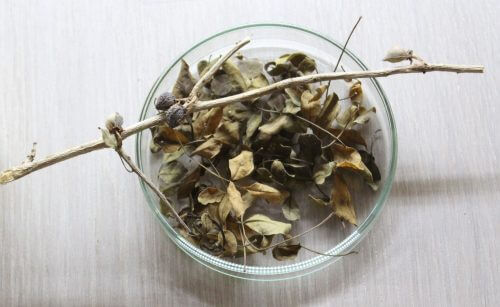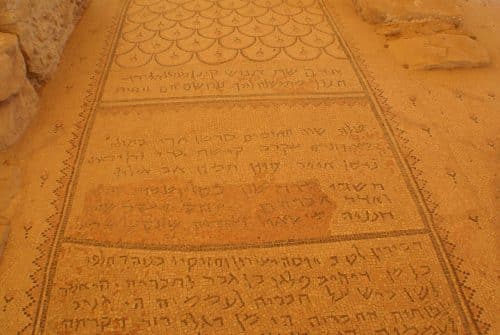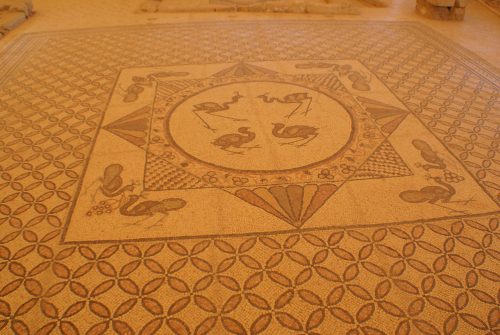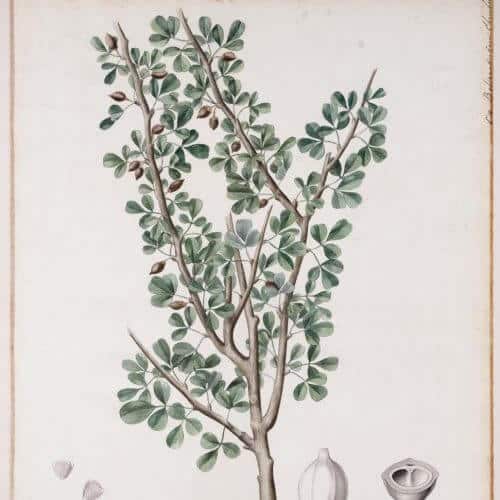About two thousand years ago, a perfume industry flourished in Ein Gedi, the secret of which only the locals knew. The perfume was produced from a tree that grew in the unique conditions of the area, it was in demand all over the country, it was used as one of the components of the incense in the temple, and with the oil it contained, the kings of Israel were anointed. A severe warning was inscribed on the floor of the synagogue to anyone who would reveal the secret

Article: Tamar Jordani, Young Galileo
Archaeologists who excavated in Ein Gedi in the summer of 1970 were amazed: in an ancient synagogue that was used by the Jewish community in Ein Gedi for nearly 300 years, from the third century to the sixth century AD, an inscription was discovered on the mosaic floor, the like of which has not been found anywhere in the world!
Curse on the floor
The community in Ein Gedi renovated the synagogue several times during the hundreds of years of its use. In the last renovation, the floor was decorated with a mosaic with inscriptions in Aramaic, which was the language then spoken in the Land of Israel. Most of the inscriptions in ancient synagogues praise the donors to the renovation of the synagogue or bless the community. But in the mosaic of the synagogue in Ein Gedi there is also a terrible curse. The curse threatens severe punishment from God on anyone who does these things:
|
|
Archaeologists wondered what troubled the community in Ein Gedi so much. Why would anyone quarrel between people or speak slander to the Gentiles? What are the "things of one's friend" that must not be stolen, and most importantly: what is the "secret of the Kriya" that is strictly forbidden to reveal to Gentiles? The curse also seems exaggerated: it is not nice to quarrel, speak slander or steal, but does the death penalty deserve the death penalty for such crimes? And in general, why write all this on the floor of the synagogue? The researchers believed that the key to solving the mystery was deciphering the "secret of reading".
For many years the researchers worked on the task, and the one who finally cracked the secret was Prof. Shaul Lieberman, one of the greatest researchers of the Talmud and the books of the Sages. He discovered that the "secret of the secret" was the process of producing the most expensive perfume in the world from the persimmon plant. It is important to note that this is not the persimmon with the orange fruit we know today, but an ancient Mediterranean plant. It turns out that the Jewish community in Ein Gedi was an international expert in growing the tree and producing its perfume for at least a thousand years! The perfume was so wonderful that it was used as one of the ingredients of the incense in the Temple, and the kings of Israel were anointed with the oil that was in it. The fate of the community in Ein Gedi, which lived in the heart of a remote desert, depended on this financial secret, so it is clear why it enacted the warning not to reveal the secret on the floor of its synagogue.

The smell of heaven
what is this plant The sources mention a very fragrant plant called simply "perfume". In the Song of Songs it is written: "My uncle went down to his bed the perfume To graze in gardens and gather roses" (chapter XNUMX, verse XNUMX), and the commentators explain that the reference is to a plant called balsam or balsan, a name similar to the Hebrew word "perfume". Later the name was translated into different languages, in which it took on interesting forms such as balsam or persimmon, and from there the path was short to "persimmon" which was first mentioned by the Greeks and later in our sources.
The historian Yosef ben Matthiyahu, who lived about two thousand years ago, described the Dead Sea region in his book "The History of the Jewish War with the Romans", and wrote: "And there is the persimmon tree, the most precious of all the fruits of that land. And the one who says this will rightly say that this land is God's garden." This description is accepted by many sources because the smell of the perfume was probably really wonderful and unusual. For example, when our sages wanted to describe the Garden of Eden, they wrote: "And when the souls of Israel enter the Garden of Eden, they are immersed in 288 rivers Balsam and persimmon and put them in heaven."
He will bless him first
The persimmon was used not only for perfume, but also for medicine and cosmetics. The historian Diodorus of Sicily, who lived about 1,900 years ago, described the Dead Sea region: "There is in these regions, in a certain valley, a tree called Balsamon from which they receive real income. Its use is for medical purposes, and it is highly valued by doctors." Another historian of the time, Strabo, wrote about the persimmon that it is "impressive in its ability to cure headache and poor eyesight". Due to its virtues, sages ruled that anyone who uses persimmon oil should bless it first. In the treatise Baruchot in the Babylonian Talmud it is said that Rabbi Yehuda offered the blessing: "Creator of the oil of our land".
An excellent description of the persimmon tree is given in the botany books written by Theophrastus, a Greek philosopher and botanist, one of Aristotle's students. Theophrastus wrote that in order to extract the persimmon oil, they would cut the trunk diagonally, tie palm fibers under the cut, and attach a shell to the lower groove to collect the resin: "The gathering is done during the summer, but the amount that drips is not great. A single person can only collect the entire shell in a day." When you understand how much effort was put into collecting every drop, you can understand the curse of the Ein Gedi community on those who dare to steal "his friend's belongings" - perhaps this is a warning against the theft of the shells on the trees, which stand unattended at night.
And he is the most beautiful
We would expect everyone to grow a persimmon tree in the yard, but it turns out that the persimmon was a spoiled tree that needed warm, dry climates and plenty of fresh water. Only experts knew how to assemble the variety that produces the most successful perfume, and the whole business required skill in making the cut in the bark of the tree at the exact angle and depth. The resin that drained was oily and transparent, it oxidized on contact with the air and became a sticky substance that was collected by hand, drop by drop.

The complicated production process of the perfume was the "secret of breeding" of Ein Gedi, which had the perfect climate for growing it. The sweet spring water of Ein Tzukim (Ein Pesha) was exactly suited to the varieties developed in Ein Gedi, and the community members planted more persimmon orchards near the springs of nearby Jericho. They found a method to mix the persimmon resin with cheaper materials without harming the clear and special scent of the perfume and also knew how to make medical ointments and oils from the parts of the tree.
The only competitors that arose for the Ma'in Gedi community were farmers from Syria, but their produce was considered less. The Greek physician Galenus, who lived almost 1,800 years ago, wrote: "The best balm is the Jew." Glenus praised the balsam of Ein Gedi which grew "in the greatest quantity and is the most beautiful, being superior to that grown elsewhere in Palestine". From this we can understand the severe warning: "He whose eyes wander throughout the earth and sees what is hidden, he will set his face against that man and his seed and uproot him from under heaven."
Cleopatra does not give up
The Romans who conquered the Land of Israel two thousand years ago took over the persimmon plantations of the entire Dead Sea region. They failed to extract the "secret of the harvest" from the farmers of Ein Gedi, but they demanded jars of persimmon perfume from them as a tax, and this led to an increase in agricultural output. One of the enthusiastic customers was Cleopatra, Queen of Egypt, who convinced her suitor - the Roman governor Marcus Antonius - to transfer to her all the persimmon taxes collected in Ein Gedi. If so, the Romans may be the "Gentiles" mentioned in the curse.
Prof. Lieberman suggested reading the words at the beginning of the inscription as a warning not to cause a conflict between people in connection with the provision of the persimmon tax to the Romans, and not to inform them if someone cheated a little in the quantities and did not provide exactly the tax he had to pay (he shall not "slander his fellow Gentiles").
What plant is this?
So what is this wonderful plant? Our sages claimed that the persimmon is the Egyptian plant mentioned in the Bible, and Rabbi Shimon ben Gamaliel explained: "The Egyptian is nothing but resin that drips from the harvest trees." The researchers speculate that this is a plant that is nowadays called Commiphora Gilead, which grew sparsely in the Middle East, mainly in Saudi Arabia.
In 2008, Guy Ehrlich, a farmer from Kibbutz Almog near the Dead Sea, decided to crack the "secret of the breeding" of Ein Gedi. He and his family established an agricultural farm of thousands of Gilead Commiphora trees to study the plant and extract the perfume from it.

"After about seven years of investigating the tree, we managed to decipher some of the secrets of the persimmon," says Ehrlich. "Other secrets are from the field of the medicinal properties of the tree, and one thing is clear: even if it is scientifically proven that only one percent of the medicinal properties attributed to the tree exist, it is a tree that carries a real message for humanity!"
Did you know?
The persimmon tree disappeared from the agricultural landscape with the conquest of the Land of Israel by the Muslims 1,300 years ago. New trade routes were opened, and through them they reached Europe in new skies from the East. The demand for the persimmon perfume plummeted until the industry was completely wiped out.
The article was published in Young Galileo - the monthly for curious children. For a gift digital sheet Click

3 תגובות
The smell of heaven... everything is relative
For those who lived during that time, they only bathed once a month when they had to go to the mikvah
Anything that smells better than a cow's morrow was the perfume of heaven
And maybe the persimmons that existed before the era of genetic engineering and the volcanic institute smelled as good as tomatoes, cucumbers, peaches, and apricots once did...
05/05/2017
Persimmon? (is that so ?)
Some time ago I was invited to visit a "persimmon" farm in the north of the Dead Sea,
It turned out to me that there is also an initiative in Ein-Gadi to plant a persimmon orchard,
Since to the best of my knowledge there is no botanical identity for persimmon in the sources I asked and checked
And it turned out to me that in both cases it is Myrrh = Commiphora Myrrha

In the sources there are mentions of myrrh, frankincense and perfumes,
The myrrh tree is common in arid areas in East Africa, in the south of the Arabian Peninsula and more,
The resin collected from it is still used today as a basis for the production of ointments,
Frankincense = Boswellia is also used for the same uses
which grows in the same geographical areas but is taller and less common,
,
The two trees are mentioned together with - in the sky,
The persimmon is mentioned later and separately,
Is it correct to identify him as the Moor?
Or maybe because the growing of the persimmon and the processing of the products from it were considered a secret
Give it a general name - in the sky?
The importance of keeping the secret of the persimmon is expressed in an inscription in the synagogue in Ein-Gadi
Cursed is anyone who reveals the secret,

The doubt increases when you know that myrrh and frankincense were known and grew not far away.
In addition to this, resin is used in myrrh and frankincense,
Whereas it turns out that almost all parts of the persimmon plant were used,
Therefore, although I am not an expert botanist
May I suggest a candidate that I think is more appropriate and correct.
In the western palace in Masada there is a mosaic in which large leaves are visible
and around them vines and palm branches,

As far as I know, there is no botanical identification of the large leaves,
It turns out that they are very similar to the leaves of Santalum album

unlike the geographically close myrrh or frankincense
Sandalwood is far from its origin in India,
https://www.hayadan.org.il/santalum-album-in-danger-2802074
Unlike the myrrh, all parts of the sandalwood are used for the production of perfumes and perfumes
The sandalwood requires unique climatic conditions for Ein-Gadi and knowledge that is kept secret
I'm short of contradicting the opinion of expert botanists and yet
May I suggest the sandalwood as a worthy candidate to be a persimmon...
No, no, no, the comiphora tree is identified with the (biblical) myrrh plant,
Persimmon has no, no! clear botanical identity,
Ten years ago I proposed to identify it with the sandalwood
santalum-album. In Hebrew it is called sandalwood.
https://www.hayadan.org.il/santalum-album-in-danger-2802074
And later I wrote a list that I can't find on the site, so I asked
To publish again!
In any case, the comfrey / myrrh is not the persimmon
The persimmon is still an enigma...